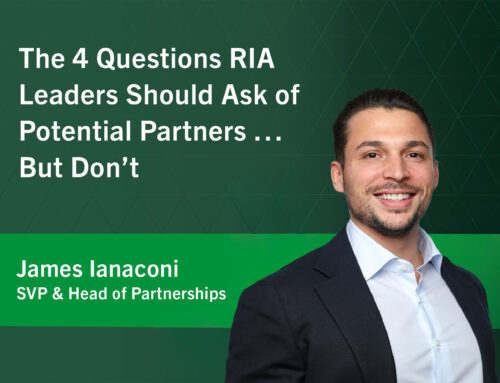By James Ianaconi, SVP & Head of Partnerships at Aspen Standard Wealth
With the S&P 500 coming off the hottest two-year streak since the 90s,[1] and the economy entering 2025 in great shape, this year represents an immense window of opportunity for RIA leaders contemplating a sale. Whether it is declining interest rates, the potential that current income tax rates and the estate tax exemption amount may not “sunset” as feared, anticipated deregulation within the financial services industry, or the belief that the current bull market could continue to trend higher, Aspen believes that the current environment is favorable for RIA owners to contemplate a strategic transaction. And all that builds upon an already robust M&A environment in the wealth sector. According to DeVoe & Company, RIA M&A activity is up 12% from 2023, with 232 deals through October 2024.
While many factors point toward a favorable situation for RIA leaders looking to exit, there is still a considerable amount of uncertainty in the market. Beyond macroeconomic factors, growth can present its own challenges: teams can be stretched to capacity or face talent shortages as clients take advantage of their firm’s success in an exit or to pursue further growth opportunities. So, it is critical for RIA leaders to engage with potential partners who have a long-term time horizon, who are committed to letting the firms they acquire build upon their legacies, vision and commitment to unwavering and best-in-class client service.
If you are an RIA leader eyeing a potential sale, below are four factors you should be considering:
Market for RIAs is expected to remain robust
There are numerous RIA consolidators in the market right now, as RIA owners, peppered with inquiries, know all too well. That competition lends itself to robust valuations for RIAs and presents many attractive options for sellers. Because of the strong activity in the market, there are also new entrants entering the space who are designing their approaches to more directly align with the long-term objectives of the RIAs the acquire.
Also, with interest rates generally expected to continue on their downward trajectory, the current economic environment is conducive for buyers of RIAs to secure more advantageous financing, which should spur them to be more aggressive in acquiring RIAs. That, too, stands to benefit RIA leaders looking to sell.
Market sentiment—and advisors’ books of business—remain firm. Despite uncertainty around the new Administration, recent S&P growth combined with potential deregulation in the financial services industry could result in a boost to client portfolios, which can have a positive impact on the overall value of RIAs. These factors, along with increased competition in the space, declining interest rates, and continued strong market conditions, can create the ideal window for strong RIA valuations in the coming months.
Succession planning expected to drive many transactions
As is the case with much of the wealth management sector, the RIA industry is getting older. The average age of RIA advisors continues to trend upward, which is a growing concern for owners focused on succession planning. For example, according to Cerulli Associates, 37% of RIA advisors plan to retire in the next decade. Even without the aging-out of advisors, it can be challenging to attract and retain top talent in this industry. Most importantly, clients want reassurance that their own financial plans will be supported with continuity.
New leaders can rise through the ranks of high-performing firms, but most RIAs need a robust pipeline of new talent to maintain growth and provide peace of mind, now and in the future. After all, advisor relationships are the most important drivers of client satisfaction[2]. That makes it critical to partner with acquirers who understand and can solve for staffing needs.
RIAs looking to stay independent but seek big firm resources to grow
The trend toward independence in the RIA space shows no signs of slowing down. Cerulli reports that independent RIAs represented the fastest-growing segment of wealth managers by headcount from 2018 to 2023[3]. A strong brand, culture, and portfolio management style are all powerful embodiments of such independence—and often drivers of client experience and retention.
Still, RIAs are seeking resources from bigger firms to make their offerings more streamlined and competitive, for example human resources, compliance, and direct marketing. Fortunately, there are opportunities for RIA sellers to maintain the characteristics that make their firms unique: to maintain their brand, their entrepreneurial culture, and their client service model. With such a broad universe of buyers, RIAs should feel empowered to seek a partner who aligns with these priorities.
RIAs seeking out acquirers who will commit to a long-term partnership
Amid all the noise and solicitations from potential RIA acquirers, those pitches can begin to sound rather similar and tend to myopically focus on valuations and potential returns. Returns are certainly important, but they are not what sets the most attractive RIA acquirers apart from the pack; it is their willingness to take a long-term approach to their partnership and investment. It also is well known that the typical PE firm will look to “flip” an RIA acquisition in just three to five years. That short-term time horizon doesn’t usually align with many RIA leaders’ real priority: to provide security to their employees and clients for the long haul. What may seem like a successful strategy by quickly cutting costs in the near term can ultimately compromise the health, growth potential, and security of an RIA.
That is why strategic RIA leaders are increasingly seeking out and partnering with potential suitors who think differently, who don’t cling to such a short-term time horizon, and who see the value in a long-term or indefinite hold. That is the sort of partnership that can benefit everyone involved for many years to come.
Contact us to explore whether 2025 could be the year to sell your firm.
[1] https://www.ft.com/content/b4136bc5-1f54-4cc8-82c9-0f4b33405a89?emailId=d8142ab7-d46c-446d-aba7-5c2daa220278&segmentId=13b7e341-ed02-2b53-e8c0-d9cb59be8b3b
[2] Aspen Standard Wealth-conducted study, 2024




